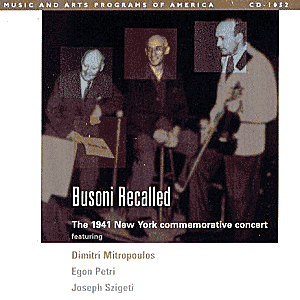AVAILABILITY
www.musicandarts.com
This New York commemorative concert was fortuitously
recorded and the discs owned by the New England Conservatory of
Music. Luckily there seem to have been at least two turntables
in use because, despite the resultant pitch fluctuations there
doesnít sound to have been any loss of music. Pitch and other
problems have been dealt with by Dimitrios Antsos and the whole
production has been overseen by Maggi Payne. So, a caveat to begin
with - there is the usual array of acetate scuffs and surface
noise and obviously some sound constriction. As broadcasts go
however, and this is a significant one, the fidelity is creditable.
It had been 75 years since Busoniís birth and
the concert was graced by a trio of musicians who had known him
to varying degrees; Petri the longest, Szigeti who championed
the Violin Concerto and also the Second Sonata and Mitropoulos
who had been introduced to Busoni by Petri in Berlin in 1920.
It was an idiosyncratic touch to open the concert with Busoniís
arrangement of the overture to Idomeneo. This was a work Busoni
had only come across a couple of years before he met Mitropoulos
but he set to work with enthusiasm, creating a concert suite comprising
the Overture, Sacrificial scene and Festal March. The commemorative
concert began with the Overture Ė boldly and vigorously etched.
Egon Petri was perhaps the greatest of all Busoniís followers
and his contribution was the Indian Fantasy. Busoniís interest
had first been piqued as early as 1910 and the Indian Dairy appeared
five years later Ė a set of four piano studies and also an orchestral
study Ė whilst the Fantasy dates from 1913-15. Petri announces
his credentials right from the opening section - glittering panache
but intensely concentrated sound Ė but heís equally a master of
linearity in Busoniís writing. The sectionality of the piece Ė
its dance and lament profile and the hieratic barbarism sometimes
unleashed Ė is compellingly coalesced in Petriís hands, aided
in no small measure by Mitropoulosís shaping of the romantic interludes.
Here he encourages some scintillatingly expressive string playing;
sepulchral basses too. But itís that G major song in the second
section that most catches in the mind. Petri voices it with perfect
delicacy and the orchestra answers with almost DvořŠkian
relish. The Vivamente section, pulsing and barbarous, with blaring
brass and dance rhythms, survives even the relatively primitive
recorded sound.
The Sarabande and Cortège came before
the interval at the concert. The former is imbued here with an
intense solemnity, highlit by its singular tread but also by those
shafts of interior beauty. Mitropoulos certainly evokes the heady
harmonic ambiguities of the latter where orchestral virtuosity
does justice to the demands of rhythm and proper tone. Because
the Two Movements from his Suite for Orchestra Geharnischte
havenít survived the recital ends with the Violin Concerto. This
had been premiered by Henri Petri, father of Egon, in Berlin in
1897. Szigeti had first played it for Busoni in about 1912, the
composer ruefully announcing that the work wasnít as bad as heíd
remembered it. We have other examples of Szigetiís performances
on record; a live RAI performance with Previtali from 1952 is
also on Music and Arts and the commercial LP with the Little Orchestral
Society under Scherman, from 1954, has appeared on Sony Classical
CD. Back in 1941 Szigeti was on fine technical form, his tone
characteristically steely but without the depletions that age
and illness later wrought. I was especially touched by the way
he darkened his lower strings for the elegiac passages and by
his commanding intellectual strength. Thereís a fine orchestral
tremolando and good tuttis as well. In the central panel, where
the soloist spins an unbroken line, Szigetiís rapt intensity is
memorable and thereís some good, crisp bowing in the finale where
his playing is not burdened by portamenti. A charming snippet
of his 1965 Harvard talk closes the disc.
This was a rare occasion in which two of Busoniís
special champions were joined by another of lesser intimacy but
no less commitment. It has a historical frisson, manages to transcend
mere associative allegiances and I found it exceptionally persuasive
listening.
Jonathan Woolf
